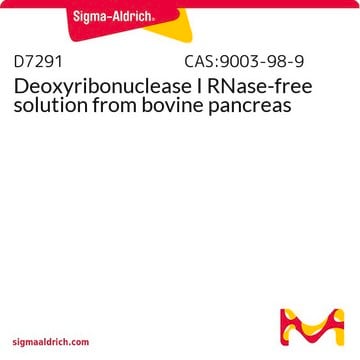D5025
Deoxyribonuclease I from bovine pancreas
Type IV, lyophilized powder, ≥2,000 Kunitz units/mg protein
Synonym(s):
DNase I, Deoxyribonucleate 5′-oligonucleotido-hydrolase
About This Item
Recommended Products
biological source
bovine pancreas
Quality Level
type
Type IV
form
lyophilized powder
specific activity
≥2,000 Kunitz units/mg protein
mol wt
~31 kDa
purified by
chromatography
composition
Protein, ≥80%
technique(s)
DNA purification: suitable
solubility
0.15 M NaCl: soluble 5.0 mg/mL, clear, colorless
suitability
suitable for molecular biology
application(s)
diagnostic assay manufacturing
diagnostic assay manufacturing
foreign activity
Chymotrypsin ≤0.5%
Protease ≤0.05%
RNase ≤0.02%
shipped in
wet ice
storage temp.
−20°C
Looking for similar products? Visit Product Comparison Guide
Application
Biochem/physiol Actions
Unit Definition
Physical form
Preparation Note
Analysis Note
inhibitor
signalword
Danger
hcodes
pcodes
Hazard Classifications
Resp. Sens. 1
Storage Class
11 - Combustible Solids
wgk_germany
WGK 3
flash_point_f
Not applicable
flash_point_c
Not applicable
Choose from one of the most recent versions:
Certificates of Analysis (COA)
Don't see the Right Version?
If you require a particular version, you can look up a specific certificate by the Lot or Batch number.
Already Own This Product?
Find documentation for the products that you have recently purchased in the Document Library.
Customers Also Viewed
Protocols
To standardize a procedure for the enzymatic assay of Deoxyribonuclease I.
Our team of scientists has experience in all areas of research including Life Science, Material Science, Chemical Synthesis, Chromatography, Analytical and many others.
Contact Technical Service














